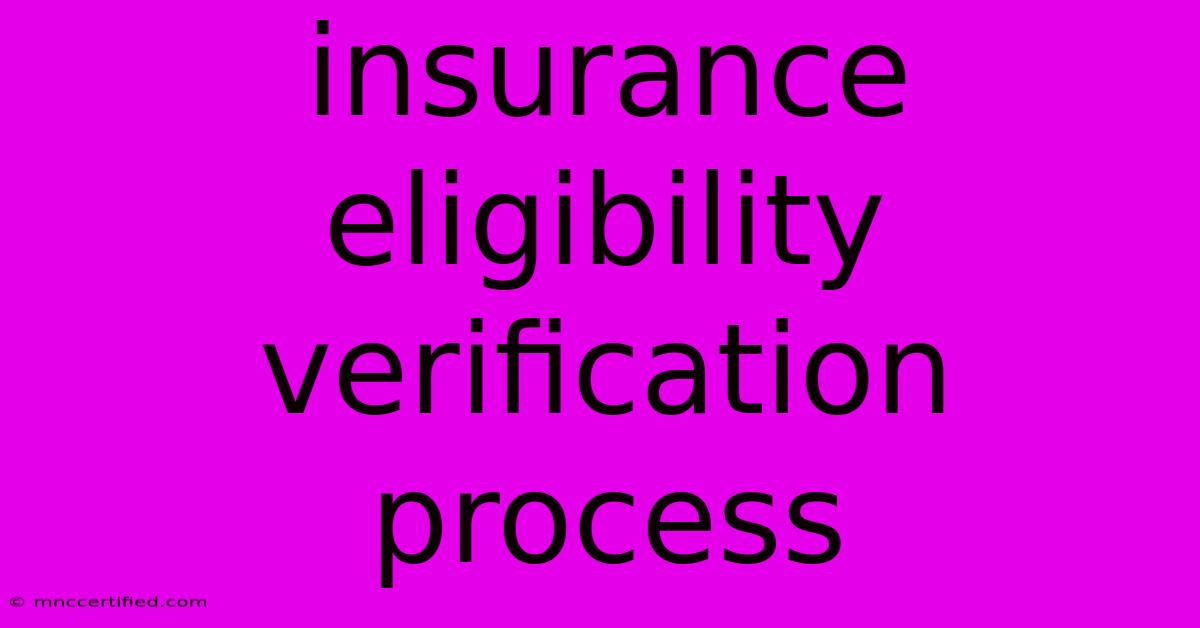Insurance Eligibility Verification Process

Table of Contents
Navigating the Insurance Eligibility Verification Process: A Comprehensive Guide
In today's healthcare landscape, understanding your insurance coverage is crucial. The insurance eligibility verification process is a vital step in ensuring you receive the care you need without unexpected financial burdens. This guide will demystify the process, outlining what it is, why it's important, and how you can navigate it successfully.
What is Insurance Eligibility Verification?
Simply put, insurance eligibility verification is the process of confirming whether an individual is covered by a specific health insurance plan and the extent of their coverage. This includes verifying:
- Plan enrollment: Whether the individual is actively enrolled in the plan.
- Coverage details: The specific benefits covered by the plan, such as medical, dental, vision, or prescription drugs.
- Deductibles and copayments: The financial responsibility the insured individual holds for services received.
- Pre-authorization requirements: Whether certain procedures or treatments need prior approval from the insurance company.
Why is Insurance Eligibility Verification Important?
The insurance eligibility verification process plays a crucial role in both patient and provider perspectives:
For Patients:
- Avoid unexpected costs: Verifying your coverage before receiving healthcare services helps prevent surprise bills and financial strain.
- Ensure access to necessary care: Knowing your plan's coverage helps you make informed decisions about your healthcare needs.
- Navigate the healthcare system efficiently: A clear understanding of your benefits streamlines the payment process and avoids potential delays in treatment.
For Providers:
- Accurate billing and reimbursement: Verified eligibility ensures healthcare providers can accurately bill insurance companies and receive timely reimbursement.
- Reduce administrative burden: Verifying eligibility upfront streamlines the billing process and minimizes administrative costs.
- Enhance patient satisfaction: By providing transparent information about coverage, healthcare providers contribute to a positive patient experience.
How to Verify Your Insurance Eligibility
The insurance eligibility verification process can be completed in various ways:
- Contact your insurance company: This is the most direct method. You can call your insurer's customer service line or visit their website to verify your coverage details.
- Use online portals: Many insurance companies offer online portals where you can access your policy information, including eligibility details.
- Contact your healthcare provider: Your doctor's office or clinic can often verify your insurance coverage through their billing system.
- Utilize third-party verification services: There are specialized companies that provide insurance eligibility verification services for both patients and healthcare providers.
Important Tips for Successful Verification
- Gather your insurance information: Have your insurance card, member ID number, and other relevant details ready before contacting your insurance company or provider.
- Be prepared for verification questions: The insurance provider or healthcare provider may ask for specific information, such as your date of birth, address, and the name of your employer.
- Request documentation: Once you have verified your eligibility, request written confirmation of your coverage to ensure accuracy and keep for your records.
- Stay informed about policy changes: Review your insurance policy regularly for any updates or changes in coverage.
Conclusion
The insurance eligibility verification process is an essential step in accessing healthcare services with clarity and confidence. Understanding your coverage, the benefits, and the process itself empowers you to navigate the healthcare system effectively and avoid potential financial surprises. By taking the time to verify your insurance eligibility, you can ensure a smooth and positive healthcare experience.

Thank you for visiting our website wich cover about Insurance Eligibility Verification Process. We hope the information provided has been useful to you. Feel free to contact us if you have any questions or need further assistance. See you next time and dont miss to bookmark.
Featured Posts
-
Grand View University Tuition 2024 25
Nov 07, 2024
-
National Investors Title Insurance Company
Nov 07, 2024
-
Pictures Of Bonded Teeth Before And After
Nov 07, 2024
-
German Bundesliga Bayern Vs Benfica Predictions And Odds
Nov 07, 2024
-
Trumps Party Wins Senate What Now
Nov 07, 2024